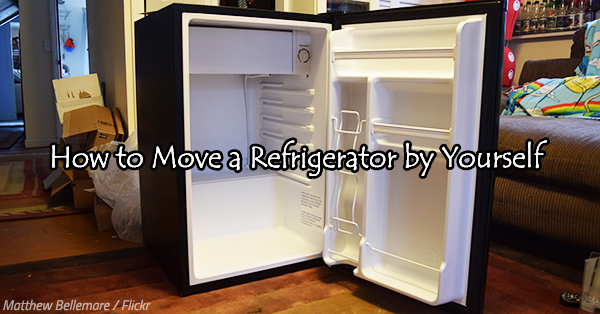 Moving a refrigerator to another home is anything but easy. In fact, most people decide to simply not take their fridges with them when they move. After the move, they either use the cooling kitchen appliance that’s already there in the new home or they buy a brand-new one.
Moving a refrigerator to another home is anything but easy. In fact, most people decide to simply not take their fridges with them when they move. After the move, they either use the cooling kitchen appliance that’s already there in the new home or they buy a brand-new one.
But every house move is different and you may make up your mind to move your fridge at all costs. And in an attempt to lower the moving expenses, you may decide to do that challenging task on your own, without the help of professional movers. Note that that relocation option can only work well when you’re moving locally.
So, you’re moving a refrigerator by yourself but you’re not sure where to begin?
Read on to learn the best way to transport a refrigerator to another home.
WHAT TO CONSIDER before moving a fridge by yourself
DECIDE whether you should move your refrigerator in the first place. Fridges are super heavy: older models can weigh around 250 lbs., while newer ones go around 170 lbs. because they are manufactured from lighter materials. Refrigerators are also rather big and bulky, so you’ll need to use a utility dolly and a few helpers to wheel it out of your home.
Is it really worth paying to move your fridge to the new home?
WEIGH UP your refrigerator moving options. Sometimes the better option may be to just leave behind your fridge due to the risk of damaging the kitchen appliance in the process, sustaining a personal injury of some sort during the relocation operation, or inflicting property damage such as floor or wall damage.
Also, remember that the serious weight of your fridge will increase greatly the moving expenses because the moving price is calculated based on the total weight of the shipment.
How much does it cost to hire movers?
WHAT YOU’LL NEED to move your fridge
Moving a refrigerator by yourself requires meticulous preparation to be able to do it smoothly from start to finish. Don’t rely on your improvisational skills – instead, make sure you are 100% ready for the challenge ahead.
First of all, here’s a list of what you’ll need to move your fridge without hiring professional refrigerator movers:
-
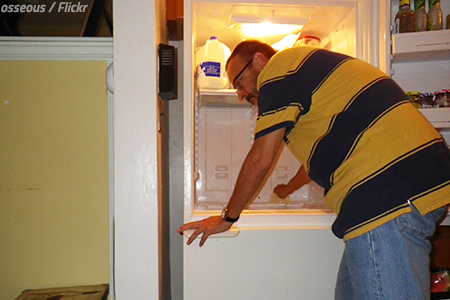
You’re going to need more than one pair of helping hands to move your fridge.
An appliance dolly, possibly with supporting straps;
- Furniture sliders;
- Rope or twine;
- Furniture blankets;
- Packing tape;
- Work gloves;
- Measuring tape;
- At least a couple of friends to give you a hand.
These packing supplies and pieces of moving equipment are essential for moving your refrigerator successfully – that is, quickly, safely, and hassle-free. Don’t rush or underestimate this preparation stage as each step is important to ensure your safety and that of your big and heavy kitchen appliance.
How to get friends to help you move
HOW TO PREPARE your refrigerator for moving
You can’t just load your fridge on a moving dolly as it is and wheel it out of your home in the direction of the moving vehicle. You can’t and you shouldn’t. You’re going to have to prepare your fridge for moving, and that preparation stage should begin at least 24 hours (preferably more) before Moving day itself.
Here are the detailed steps to prepare a fridge for a move:
- TAKE OUT all the food and drinks from your fridge a few days prior to the move. Then, make up your mind about what you’ll do with all those food items – will you use them up on time or give them away to somebody who needs them?
- UNPLUG your refrigerator from the power supply. In case your refrigerating unit has a separate ice dispenser and a water dispenser, then disconnect those from the water supply as well.
- DEFROST the fridge by keeping its door open for a few hours or by using the special defrost mode, if any. Catch the water in suitable containers to avoid a bigger mess. To complete the defrosting task faster, you may want to use a hair dryer to melt the accumulated ice inside it.
- CLEAN your fridge before moving it – that’s a must-do task that’ll save you a few headaches along the way. Use a soft non-abrasive sponge and a mixture of water and baking soda to clean the inside surfaces of your household appliance.
- TAKE OUT all removable components from the inside of your fridge – shelves, drawers, lids, etc. Clean those too, then wrap them up in packing paper when they are completely dry. Wrap the more fragile parts in bubble wrap. Once protected, transfer them all into a large cardboard box for safe transportation.
- LET the fridge door slightly open to prevent the buildup of mildew while your refrigerator is drying up after being cleaned up. In case you can still smell bad odors coming from its inside, then you can try to neutralize them by placing inside a small container full of baking soda.
Now that you know how to clean and how to defrost a refrigerator for moving, it’s time to start working on your refrigerator moving plan.
How to stay organized when moving house
HOW TO PLAN a fridge moving strategy
Before you start moving your refrigerator out of your home, you’re going to need a good working plan and a clear exit path. In other words, think a few steps ahead to avoid getting stuck while moving your refrigerator.
-
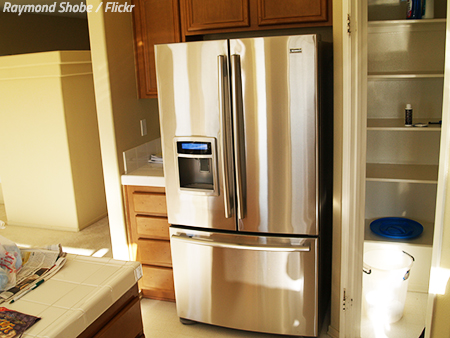
Some fridges are harder to move than others.
REFER to the refrigerator’s manual to learn its exact dimensions. If you don’t have it, then use your measuring tape and measure up its height, width and depth.
- MEASURE all doorways and hallways along the exit route and see if your fridge will fit through them without problems. If yes, then you have nothing to worry about. If not, consider removing temporarily a door off its hinges, or click here to learn what else you can do to make furniture and appliances fit through tight openings.
- WALK the intended exit paths and make sure there are no obstacles of any kind on them. If there are, just remove them. Also, ensure that the paths are completely dry and safe – that is, no water, mud or snow is present on them.
- DISCUSS with your helpers how exactly you’re going to wrap, load and move out the large fridge out of your home. Go through each little detail with safety being your top priority.
How to survive Moving day in 20 steps
HOW TO PREVENT serious floor damage
When moving a refrigerator that can easily pass the 200-pound mark, proper floor protection becomes vital. Your house move will already be expensive enough, so you wouldn’t wish to add costly floor damage to the final moving bill, would you?
Regardless of the type of flooring in your home – hardwood, tiles, vinyl or carpet, you need to make sure that your huge fridge won’t damage the floors in any way. Luckily, there are a couple of effective floor protection methods that will help you keep your floors damage-free throughout the move.
#1. Furniture sliders
If your fridge is positioned between other kitchen appliances or furniture pieces, you’ll need to take it out of its resting place without scratching the floor. To do that, have you helpers tilt slightly the fridge while you place a furniture slider under each leg or side. As you know, furniture sliders are made of hard rubber or plastic and will decrease greatly the friction between the heavy household item and the floor, thus eliminating the risk of floor damage.
Once the furniture sliders are in place, pull back the kitchen appliance by sliding it backward. Then, you can slide your fridge almost effortlessly toward where you want it to go, usually in the direction of the kitchen door.
Rent furniture sliders from a local moving company, or buy them from a close-by home depot store, or order them online.
#2 Appliance dolly
A great way to protect floors when moving a refrigerator is to use a high-quality appliance dolly (the two-wheel L-shaped lever) to move your big appliance around. In fact, the rubber wheels of the moving dolly will ensure that your fridge never touches any part of the floors during transportation.
Below you will learn more about how to move a refrigerator with a dolly, especially when it comes to the loading process. You can rent an appliance dolly (aka a hand truck) from a local mover or buy one from a home depot store.
How to move a washing machine without movers
HOW TO PACK a refrigerator for moving
Packing a fridge for moving is pretty straightforward – you only need to wrap it in protective blankets to add that important layer of extra protection for the expensive kitchen appliance.
Use the 3 packing steps below to protect your fridge when moving house:
-
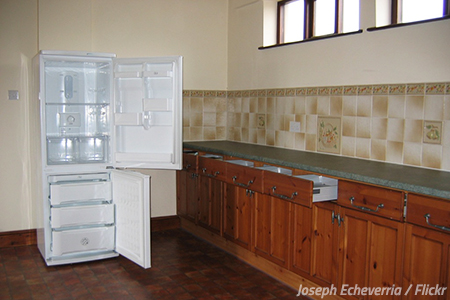
It looks like you’re ready to pack your fridge now.
CLOSE the door of the fridge, wrap the entire appliance with protective blankets, and then use pieces of tape to keep those covers in place. Furniture blankets work best but you can use ordinary blankets as long as they are soft enough as to not damage the delicate surface.
- SECURE the door with a piece of twine or string to make sure it won’t open during the move. Remember that you should never turn your back on safety when moving your fridge to another home.
- FOLD UP the power cord, use a cable tie to keep it secure and tape it to the back of the appliance. This way, you’ll prevent the possibility of somebody tripping over the power cable during transport.
How to pack heavy items for moving
HOW TO MOVE a fridge with a dolly
When moving a fridge to a new home, you want to use an appliance dolly to move the appliance safely. In fact, it’s the only way to guarantee the safety of the entire fridge moving operation – rest assured that professional movers with many years of experience use the right type of moving dolly as well.
Here’s how to move a refrigerating with a dolly:
- SLIDE OUT the fridge if it’s wedged between other appliances or if it’s too close to the wall to be loaded onto a dolly. Do it by using furniture sliders as described above.
- PACK your refrigerator with protective blankets as narrated above. Check whether the power cord is well-secured as well.
- HAVE the moving dolly close to the packed fridge, then have your helpers tip the appliance just a fraction so that you can slide the dolly underneath it.
- TILT BACK the moving dolly, together with your friends, so that the fridge gets balanced on the L-shaped lever. Do this slowly to keep the refrigerator from slipping sideways.
- SECURE the refrigerator onto the dolly using the built-in straps. For extra safety, use a piece of strong rope to immobilize the kitchen appliance.
- WHEEL the fridge out of your home but exercise great caution as you’re doing it. Whatever you do, do it slowly and carefully while keeping in mind that your safety and that of your helpers is your number one priority.
- BE advised that it’s better to pull the fridge-loaded dolly than to push it because you’ll be able to maneuver more easily while keeping the risks lower too.
- GO through doorways and hallways extremely slowly while your helpers are keeping the load steady with their hands. When faced with an obstacle, stop and think things through instead of going forward without a good plan of action.
- GO one little step at a time when moving a refrigerator downstairs. It’s a risky task for non-professionals so if there are too many stairs between you and the moving vehicle, it’s usually better to hire professionals to help you out. If not, then keep the refrigerator tilted at approximately 45 degrees to control the descent while your helpers are keeping the big load steady.
- USE the loading ramp of the moving truck to pull the fridge up safely. When loading a refrigerator into a pickup truck, then make sure the vehicle has a suitable loading ramp as well.
- SECURE the loaded household appliance to the side of the truck with the help of ratchet straps or strong rope. ALWAYS transport your refrigerator in an upright position – avoid laying it on its side during the haul to prevent avoid untimely damage to its cooling mechanism – see below for details.
Safety tips for moving furniture
HOW TO KEEP your fridge safe at all times
A refrigerator may look very robust, almost indestructible, but the truth is that fridges are rather fragile appliances due to their delicate cooling mechanisms.
Here are a few safety tips that should help you keep your fridge 100% safe when you’re moving it to another home.
-
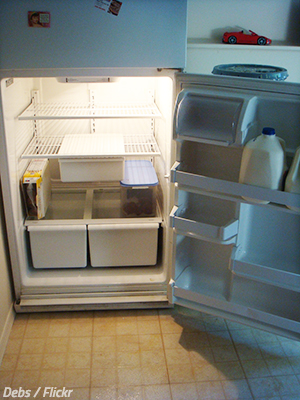
You’ll need to wait a while before you can use the fridge in your new home.
DO NOT LAY DOWN a refrigerator while moving it, at least not for a prolonged period of time. Moving a refrigerator on its side is a bad idea because the compressor unit from the cooling mechanism runs on oil, and when a refrigerator is laid down on its side or over-tipped during transport, that same oil will flow into the cooling lines and may damage your refrigerating unit.
- WAIT at least 3 hours before you plug in and turn on your fridge after it’s been moved to the new home. The reason for this safety tip is that the oil of the kitchen appliance will begin to make its way from the cooling lines to the compressor as soon as your refrigerator is positioned in its new place. So, you’ll need to wait until all the oil makes it back to the unit compressor before you can plug it in and turn it on safely.
- DO NOT RISK getting your expensive kitchen appliance damaged or ruined forever if you’re not confident that you can handle the tough refrigerator moving task without professional assistance. If leaving behind the fridge is not an option and you feel nervous about handling that big, heavy and yet fragile appliance, then get in touch with professional fridge movers.

